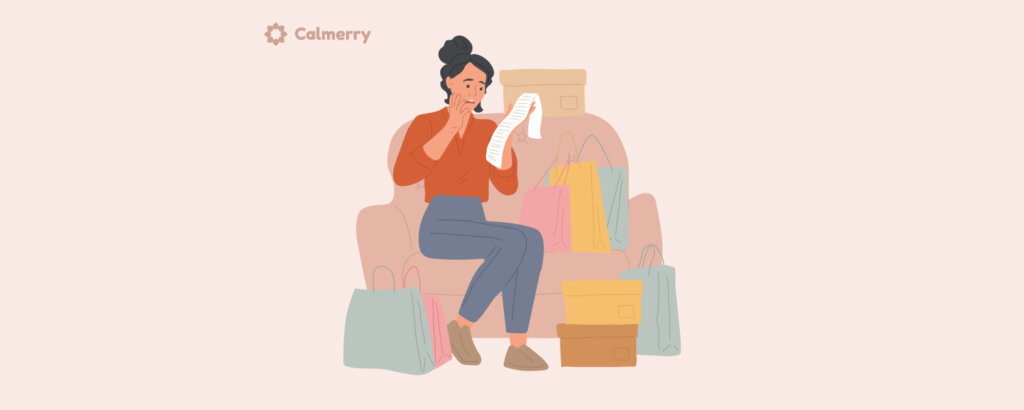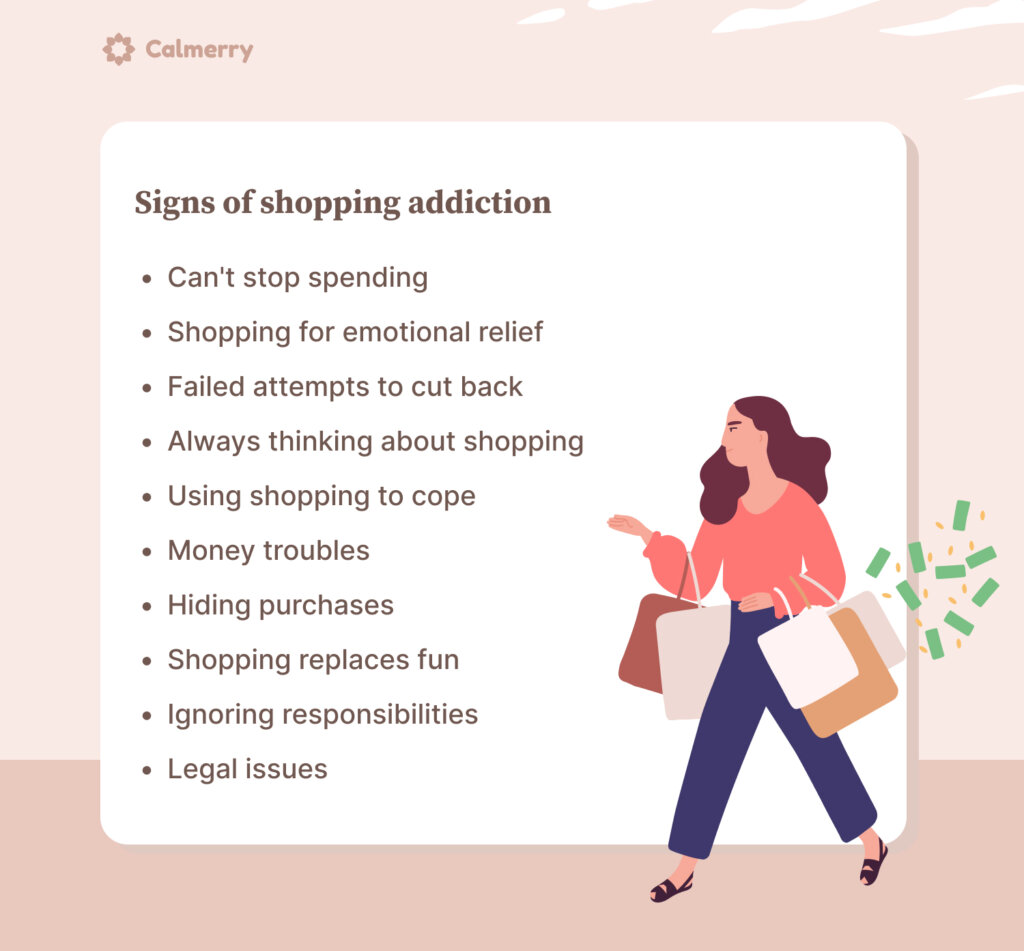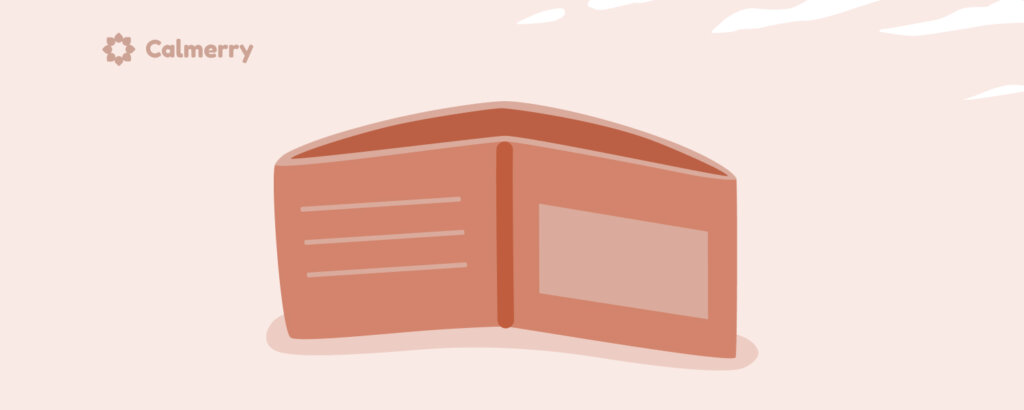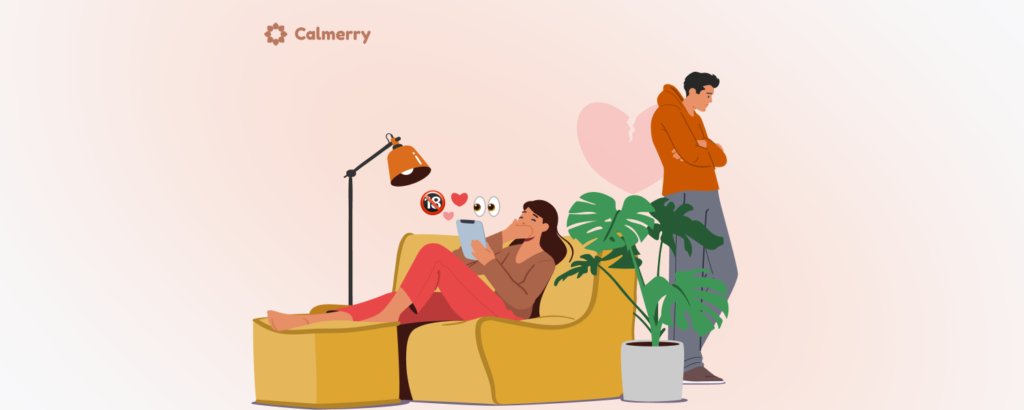Shopping Addiction: Recognizing Causes, Signs, and Symptoms

In this article
Shopping addiction isn’t just about overspending—it’s an emotional vortex that can drain bank accounts, fuel guilt, and even isolate people from loved ones.
But the consequences might be deeper than just financial difficulties. Many who are with shopping addiction engage in these purchasing behaviors to cope with stress, loneliness, or boredom, only to feel worse afterward. [1] Cassidy, T., & Adair, Z. (2021). Psychological Aspects of Shopping Addiction: Initial test of a stress and coping model. International Journal of Psychological and Brain Sciences, 6(2), 29. https://doi.org/10.11648/j.ijpbs.20210602.12
However, shopping addiction is treatable. With the proper guidance, people can overcome their urges and improve their relationships with spending.
What is a shopping addiction?
Shopping addiction, also known as compulsive buying disorder or oniomania, is a type of behavioral addiction marked by an uncontrollable urge to shop. Those who develop a shopping addiction often engage in compulsive shopping habits, driven by emotional factors like stress, loneliness, or the need for a “high” associated with shopping.
The impact of shopping addiction
Financial problems
Compulsive shopping often leads to empty savings accounts and difficulty paying for necessities. Some people struggling with a shopping addiction take loans to finance their habit, digging themselves into deeper financial pits, which ultimately may lead to destroyed credit histories and bankruptcy.
Emotional distress
Rather than bringing happiness, excessive shopping often leaves people feeling empty, guilty, or anxious afterward. This pattern can spiral into depression, shame, or a loss of control.
Relationship issues
When spending gets out of hand, partners or family members may feel deceived or resentful about financial secrecy. Trust erodes as arguments over money become frequent, sometimes leading to isolation or broken connections. Loved ones often struggle to understand or support compulsive buying behavior.
Decline in overall well-being
Rather than putting a shopping addict in a good mood, excessive shopping leaves individuals guilty, hollow, or apprehensive.
Signs of shopping addiction
Here are some common signs and symptoms of shopping addiction that you need to pay attention to.
Compulsive spending
The urge to buy is unstoppable, even when unnecessary. Spending feels uncontrollable and often leads to regret, whether it’s small daily purchases, like a mug, or large splurges, such as kitchen furniture.
Emotional attachment
Shopping isn’t just about buying things, but a way to fill an emotional void. The excitement of a new purchase provides a fleeting high, but the satisfaction quickly fades, leaving guilt or emptiness.
Loss of control
No matter how many times they promise to stop, they can’t. Attempts to set budgets or cut back fail, and shopping becomes a cycle of repeated excess.
Preoccupation with shopping
Their mind is constantly occupied with shopping, endlessly scrolling online stores, making wish lists, or planning the next purchase, even when they don’t intend to buy anything.
Shopping to relieve negative emotions
When people feel stressed, sad, or bored, they shop for instant comfort. But instead of solving the problem, it only creates a temporary escape, followed by more distress.
Financial issues related to shopping
Mounting credit card debt, drained savings, and unpaid bills become a reality. Despite knowing the consequences, the spending continues, digging a deeper financial hole.
Secrecy around shopping habits
They hide their shopping receipts, lie about purchases, or downplay how much they’ve spent—afraid of judgment or confrontation from the family.
Shopping as a recreational activity
Rather than socializing, pursuing hobbies, or relaxing, they default to shopping as their main source of entertainment, whether online or in stores.
Neglecting responsibilities
Work, family duties, or personal commitments get neglected because shopping becomes the priority, leading to missed deadlines or strained relationships.
Legal issues
In extreme cases, uncontrollable shopping may lead to desperate actions—fraud, theft, or other legal issues just to fuel the habit.

Causes of compulsive shopping
Sometimes, it’s hard to tell whether the urge to shop comes from deep within or what triggers it. Here are some common reasons that lead to compulsive shopping.
Mental health conditions
Emotional pain such as depression, anxiety, or low self-esteem can trigger compulsive buying. For some, shopping and spending money is a short-term escape from distressed feelings, and hence a cycle develops where shopping turns into a coping strategy more than an instrumental requirement. [2] Lo, H., & Harvey, N. (2012). Effects of shopping addiction on consumer decision-making: Web-based studies in real time. Journal of Behavioral Addictions, 1(4), 162–170. https://doi.org/10.1556/jba.1.2012.006
Personality characteristics
Certain personality types, such as impulsivity, perfectionism, or high need for approval, may increase the risk of compulsive buying. Those with low self-control or who like instant gratification may have difficulty avoiding overspending.
Materialism
In a world where possessions are sometimes equated with success, others go shopping to feel worthy or successful. Believing that one should be happy with more may lead to compulsive buying.
Exposure to advertising
Constant marketing, through social media, ads, and influencers, creates a feeling of need to buy. Personalized promotions, limited-time special offers, and FOMO can make people spend more than they can afford.
Retail therapy
Most people use shopping as a way to lift their mood during stress or depression. While buying something new provides one with a temporary psychological lift, it may have long-term psychological and financial consequences if done habitually.
Psychological factors in excessive shopping
Excessive shopping often stems from emotional triggers (stress, boredom) or cognitive patterns like seeking instant gratification. Low self-esteem or materialistic values may also contribute.
How culture shapes spending
Consumer culture, social media, and targeted advertising normalize frequent purchases. Societal pressures to “keep up” with trends or equate possessions with success can fuel overspending, making it harder to resist unnecessary buying. [3] Sathya, J, Babu, M, Gayathri, J, Indhumathi, G, Abdul Samad, Z & Anandhi, E 2023, ‘Compulsive Buying Behavior and Online Shopping Addiction of Women’, Information Science Letters, vol. 12, no. 5, pp. 1641- 1650. https://doi.org/10.18576/isl/120512
Instincts behind shopping
Dopamine release during purchases can create a reward-driven shopping habit. Genetic factors or neurological differences in impulse control may also increase susceptibility to compulsive spending, making it a biologically influenced behavior for some individuals.
Compulsive vs. impulsive shopping: key differences
Compulsive shopping is driven by emotional distress, it’s repetitive, and difficult to control.
Impulsive shopping is characterized by spontaneity, impulsivity, and a focus on momentary desires.
While both lead to overspending, compulsive buying is more habitual and tied to emotional regulation.
Types of addiction to shopping
There are different types of shopping addiction that you should be aware of.
Impulse buying
Driven by sudden urges rather than necessity, this behavior involves unplanned purchases, often resulting in buyer’s remorse and financial strain.
Deal chasing
The compulsive pursuit of discounts and sales overrides rational spending, leading to unnecessary purchases simply because they seem like a “good deal.”
The collector
An obsessive need to acquire specific items, often as part of a set, fueled by emotional fulfillment rather than practical use.
Shopping spree
Intense, short-lived spending sprees, similar to binge eating, where large amounts of money are spent impulsively, usually during emotional distress.
Bulimic shopping
Bulimic shopping refers to a destructive cycle of compulsive buying followed by guilt-induced returns or discarding purchases, creating temporary relief but long-term distress.
What is the difference between normal shopping and shopping addiction?
Normal shopping is planned, budget-conscious, and need-based. Shopping addiction involves compulsive, uncontrollable spending. While regular shoppers feel satisfaction, addicts experience temporary relief followed by guilt. Recognizing this distinction is key to identifying problematic behavior.
How to cope with shopping addiction
Develop other coping strategies
When you feel the urge to shop, redirect your focus to activities like exercise, creative hobbies, or deep breathing exercises. Understanding emotional triggers, such as stress or loneliness, helps choose healthier responses. Journaling can also provide clarity, making it easier to break the cycle of impulsive spending.
Rely on your support network
Opening up to close friends, family, or a therapist creates a network of accountability. Support groups specializing in compulsive spending can provide a shared experience and practical advice. External encouragement strengthens resolve and provides alternative perspectives on managing urges.
Reduce financial triggers
Switching to cash-only purchases, setting strict budgets, or temporarily blocking shopping websites can nurture impulsive habits. Removing saved credit card details adds an extra step, allowing time to reconsider unnecessary purchases. Small barriers help reinforce mindful spending.
Shop with the right company
Spending time with those who encourage restraint, rather than indulgence, helps maintain progress. If social outings involve shopping, suggest alternative activities.

How to stop a shopping addiction
To reduce shopping addiction, identify triggers and set spending limits. Use cash instead of cards, avoid impulse buys, and unsubscribe from marketing emails. Replace shopping with healthier pursuits, such as exercise or hobbies.
How Calmerry can help with shopping addiction?
Calmerry offers online therapy with licensed professionals who help identify triggers, develop healthier coping strategies, and build mindful spending habits. Personalized support makes it easier to regain control and improve your well-being, all from the comfort of your own home.
FAQ
What is shopping addiction?
Shopping addiction is a complex behavioral addiction where individuals rely on shopping as a means of emotional relief. People with shopping addiction experience excessive shopping episodes despite negative consequences.
What are the main signs and symptoms of compulsive shopping?
Warning signs include frequent shopping sprees, hiding purchases, financial strain, and withdrawal symptoms when not shopping. People with shopping addiction often feel guilty after spending.
What are the causes of shopping addiction?
Potential causes include emotional distress, low self-esteem, and reliance on shopping for temporary relief. Online shopping addiction may worsen due to easy access.
How is shopping addiction different from normal shopping habits?
Unlike occasional shopping, compulsive shopping behaviors are uncontrollable, leading to debt or distress. Individuals with shopping addiction shop to cope, not just for needs.
Can shopping addiction lead to financial problems?
Yes, shopping addiction will often result in debt as people with this addiction overspend to fund their shopping habits, creating a harmful cycle of shopping.
What impact does compulsive shopping have on mental health?
Shopping addiction may also cause anxiety, depression, and shame. Shopping provides temporary relief but can worsen emotional distress in the long term.
Is shopping addiction linked to other mental health disorders?
Yes, it’s associated with shopping addiction and disorders like depression or gambling addiction. Compulsive behaviors related to shopping often co-occur.
How can someone recognize if they have a shopping problem?
Signs include frequent shopping sprees, inability to stop shopping addiction, and financial issues. Individuals struggling with shopping addiction may feel out of control.
What are effective strategies for coping with shopping addiction?
Help for shopping addiction includes setting spending limits, avoiding triggers, and seeking shopping addiction treatment options like therapy.
Are there professional treatments available for shopping addiction?
Yes, a professional addiction treatment plan includes CBT and support groups. Overcoming shopping addiction is possible with structured addiction treatment options.
- Cassidy, T., & Adair, Z. (2021). Psychological Aspects of Shopping Addiction: Initial test of a stress and coping model. International Journal of Psychological and Brain Sciences, 6(2), 29. https://doi.org/10.11648/j.ijpbs.20210602.12
- Lo, H., & Harvey, N. (2012). Effects of shopping addiction on consumer decision-making: Web-based studies in real time. Journal of Behavioral Addictions, 1(4), 162–170. https://doi.org/10.1556/jba.1.2012.006
- Sathya, J, Babu, M, Gayathri, J, Indhumathi, G, Abdul Samad, Z & Anandhi, E 2023, ‘Compulsive Buying Behavior and Online Shopping Addiction of Women’, Information Science Letters, vol. 12, no. 5, pp. 1641- 1650. https://doi.org/10.18576/isl/120512
online therapy
live video session



